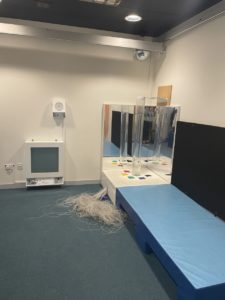
The multi-sensory rooms were designed following the idea of the ‘Snoezelen’ activity promoted in Holland.
The word ‘Snoezelen’ is a combination of two Dutch words meaning to ‘sniff’ and ‘doze’. Snoezelen is an activity that takes place in an attractively lit room where soft music is heard.
The term Snoezelen is no longer used as ‘Multi-sensory room’ is a more appropriate description. Multi–sensory rooms have several functions;
- Eliminate stimuli that the child finds aversive
- Gradually increase the child’s tolerance of particular stimuli.
- Reduce distractions and provide a calming environment.
- Enable staff to identify which stimuli provide the most pleasure and interest – It may be possible then to use the Sensory environment to:
- Promote understanding of cause and effect
- Develop assertiveness and confidence
- Facilitate engagement, interaction and communication
- Promote exploration and play.
Multi-sensory rooms provide a relaxing and calming environment where staff can support pupils, identifying strengths and the development needs of individuals, consolidating existing skills, and developing new skills in a motivating and stimulating way.
In Calaiswood School many pupils benefit from using the Multi-sensory rooms and the activities within them.
We use Multi-sensory rooms for individual or group activities, during leisure time, to relax, or as 1:1 sessions where activities are more structured and designed to develop specific skills.
There is equipment to provide visual, auditory, tactile, kinaesthetic and olfactory stimulation.
Multi-sensory environments have bubble tubes, special lighting with a projector to cast slow-moving images or colours around the walls, and a mirror ball with spotlight and fibre-optic sprays. There may be other lamps, music or sound equipment and aromatherapy materials. A variety of tactile items can be provided, such as cushions and vibrating pillows or mattresses, as well as massage chairs. Panels with a variety of textures such as rough surfaces, stiff bristles, smooth or contoured mirrors, beads, or soft and squashy objects are often also included.
In order to let the children know what is going to happen next we use a variety of strategies including photos, symbols and symbolised strips. Participants learn to use the equipment as independently as possible, using switches and other controls to turn lights on, off, or to change colour and pattern.
There is a box of supportive equipment for low tech sessions. Children are able to control the equipment or just simply explore it in different positions.
There are options for parents at home to create their own Multi-sensory room, but as some equipment is very expensive, you may choose to go for a low tech version and gather some resources from different websites/catalogues available:

